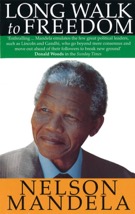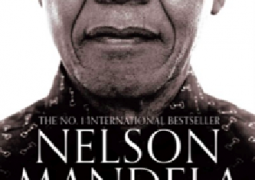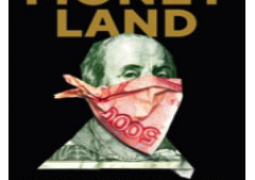
Reviewed by Mark O. Hatfield
On 10 May 1994, South Africa held celebrations to mark the inauguration of the first president it had ever chosen through nonracial elections. The new president was Nelson Mandela, a 75-year-old black man who decades earlier had initiated an armed struggle against the white-controlled apartheid regime and spent 10,000 days in prison for his revolutionary activities. His release from this long captivity in February 1990 marked the beginning of the end of apartheid. This memoir is Mandela's own story, tracing his life from boyhood to the leadership of the outlawed African National Congress (ANC), the 1993 Nobel Peace Prize that he shared with then-President Frederik W. de Klerk, and the presidency.
Mandela had earlier put his story on paper, only to have it confiscated when construction workers accidentally uncovered its hiding place. The present volume, written and published after his 1990 release, gracefully and reflectively combines an account of his life with the larger story of the growth of the revitalized ANC and the efforts of nonwhite South Africans to claim the freedom so long denied them. He describes the larger aspects of the struggle against apartheid, always emphasizing that it was a collaborative effort bringing together vast numbers of people, while retaining the essential human tone and singular outlook of an autobiographer. Some passages are as striking as they are simple, such as the sentence where he tells of being allowed to embrace his wife after 21 years of enforced physical separation.
Mandela's narrative takes us back beyond the already-familiar terrain of his later public career, into the world of black South Africa and its tribal history. Born in a small village in the Xhosa-speaking southeastern region of Transkei in 1918, Mandela was groomed--as his father had been before him--to serve as a counselor to the rulers of the Thembu tribe. His domestic ties were strong--Mandela ruefully notes how often his work as a freedom fighter deprived him of any possibility of a normal family life-- and his education extensive. He attended University College of Fort Hare, an institution founded by Scottish missionaries that was the only residential center of higher learning available to blacks in South Africa. Later he read law at the University of Witwatersrand, completing his course of studies in 1942.
It was at school, Mandela observes, where he learned that the simple freedoms of his provincial, rural boyhood were an illusion: the harsh truth was that he and all South Africans of color were shut out of the political system and denied fundamental rights. While living in Johannesburg, Mandela gravitated the three-decade-old ANC, which he joined in 1944. It was not long before Mandela and other rising young figures like Walter Sisulu and Mandela's law partner Oliver Tambo began to mount a militant challenge to the ANC's aging leadership. Unhappy with the passive-protest strategy of past years, the younger men began to orchestrate strikes and publicly denounce the official policy and ideology of apartheid, or racial separation, that the National Party (NP) government of Prime Minister D.F. Malan elaborated in a string of measures starting in 1948 and stretching into the early 1960s under successive NP cabinets.
For Mandela, the essential principles of the long struggle for freedom are to be found in the ANC's 1955 Freedom Charter, which emphasizes nonracialism, liberty, and individual rights. First arrested and imprisoned in 1952 for his role in the "Defiance Campaign" of nonviolent civil disobedience directed against apartheid laws, Mandela was free in time to take part in the deliberations that led up to the drafting and presentation of the Charter. The official response was the arrest on charges of high treason of 156 antiapartheid activists in late 1956. For the next four and a half years, Mandela and his colleagues were in the dock, with Mandela himself acting as defense counsel for the final year of this "Treason Trial."
When the court at last found the defendants not guilty in March 1961, the outraged government of Prime Minister Hendrik F. Verwoerd (the architect and leading ideologist of apartheid) reacted with redoubled repression, intensifying the exclusion of the black majority and often ignoring the rule of law. Mandela soon went underground; by mid-1961, he had concluded that the tactics of nonviolence were failing and that an armed resistance movement had to be created. He carefully explains his reasons for deciding to lead the ANC's guerrilla wing, called Umkhonto we Sizwe (Spear of the Nation, or MK). Despite his role in the founding of the MK--his activities included trips throughout Africa to solicit weapons and funds--Mandela insists upon his preference for nonviolence. The MK was a last resort, he argues, formed in order to keep the antiapartheid struggle from dying in its tracks. Attacks, in Mandela's conception, were to be aimed at government installations and white-owned property, but not at people. The aim was not to spark a race war, but to get the government to negotiate. At the same time, however, Mandela makes no bones about his willingness to raise the level of violence if he thought that circumstances demanded such a step. "If sabotage did not produce the results we wanted," he observes, "we were prepared to move on to the next stage: guerrilla warfare and terrorism" (pp. 246-47).
A question left unanswered in this book is whether Mandela would agree today that the MK became unnecessary in the later years of apartheid, when the world had turned its back on a whites-only regime that was struggling under economic sanctions and facing ever-greater isolation with the collapse throughout southern Africa of white-run buffer states or colonies like Rhodesia, Angola, and Mozambique.
Another—and quite understandable—gap is the lack of comment on the growing militancy, in the 1980s especially, of extreme black-nationalist (or "Africanist") movements, including the ANC's own youth wing. Generations of black South Africans have suffered the disastrous effects of the apartheid regime's Bantu Education program, which beginning in the early 1950s sponsored a government takeover of religiously affiliated schools like the Methodist institutions that had taught the young Nelson Mandela.
The takeover and other aspects of the program were designed to keep blacks from receiving anything more than the most rudimentary instruction, and the design succeeded only too well: tragically for themselves and their society, many young people wound up rejecting education altogether. Mandela, Tambo, Sisulu, and their ilk belonged to a generation of black leaders notable for their willingness to pursue liberation aggressively, but they also retained a sense of prudence and foresight that seems disturbingly lacking among some younger leaders who have risen amid the poverty and frustration of the townships.
Mandela was continuously imprisoned from 1962 to 1990, with extremely limited access to news during all but the last part of that period. It is thus hardly surprising that his book is limited in its coverage of the attitudinal shifts that occurred among black South Africans as apartheid's ugly career wore on into its fourth decade. In a sense, his isolation was a blessing, for he was spared personal involvement in a cycle of protest and repression that was becoming more and more vicious as its stakes grew ever higher. From the mid-1980s on, many observers believed that Africa's wealthiest nation was headed inexorably for a bloodbath, and few believed as late as 1993 that a peaceful transition to multiracial democracy was possible.
Mandela takes great pains throughout to emphasize the ANC's commitment to a nonracial society, personally underlining his message by recounting small but meaningful human encounters with prison warders and other whites as well as the speech that he gave over and over while campaigning for the presidency. "I reminded people again and again," he writes, "that the liberation struggle was not a battle against any one group or color, but a fight against a system of repression" (p. 540).
Mandela's firm support of the participation of the South African Communist Party (SACP) in the struggle against apartheid was always controversial. Nonetheless, he was and is careful to point out that he was not an SACP member. Writing about the Treason Trial, Mandela says: "The state was determined to prove that I was a dangerous, violence-spouting Communist. While I was not a Communist or a member of the party, I did not want to be seen as distancing myself from my Communist allies. . . . I did not hesitate to reaffirm the tremendous support the Communists had given us" (pp. 218-19). Later, when he was establishing the terms of negotiations with then-President P.W. Botha in the late 1980s, he assured the president that the ANC was not under Communist control, but refused the government's demand that the ANC break with the SACP. "Which man of honour," he wrote Botha in early 1989, "will desert a lifelong friend at the insistence of a common opponent and still retain a measure of credibility with his people?" (p. 476).
The universal principles of freedom and enfranchisement for all are at the heart of the ANC and Mandela's political success. On no other grounds--whether group rights, black-nationalist authoritarianism, or any other proposed regime--could the nation have been peacefully united. Over the years, private exchanges with government officials and judges reinforced Mandela's belief that the regime could not make an honest case against the ANC's position, but rejected it because it went against ingrained beliefs about black inferiority.
Mandela's 27-year stretch in prison began with his capture in Natal in August 1962. At first sentenced to five years for inciting unrest and illegally leaving the country, he was tried along with other ANC leaders captured in 1963 for sabotage and attempted overthrow of the government. This so-called Rivonia Trial might well have ended in a death sentence for Mandela, but the pressure exerted worldwide on behalf of the defendants was great and in the end the Afrikaner judge imposed life imprisonment instead.
Nearly half the book describes in sometimes chilling detail Mandela's experiences as a prisoner. He and the other political prisoners were held apart from ordinary inmates, but conditions were infamously rough, especially at Robben Island, the notorious penal colony in Table Bay off Cape Town, where Mandela was held from 1964 to 1982. Ironically yet characteristically, Mandela writes less about the general difficulties of prison life than about his efforts to ensure racial fairness inside the walls. The man who struggled for the political enfranchisement of nonwhite South Africans on the outside also fought for a black man's right to wear long pants and eat the same food as nonblacks on the inside. Mandela endured decades of incarceration, the crumbling of two marriages, heart-wrenching separations from his family (including, most poignantly, the death of his mother while he was behind bars), and a bout of tuberculosis brought on by damp prison cells, and emerged from it all, remarkably, with malice toward none. What steeled him to overcome these hardships was his belief that his cause was just and that the essential human spirit, even that of his oppressors, was good. As Mandela writes in his final chapter, "I never lost hope that this great transformation would occur. . . . I always knew that deep down in every human heart, there is mercy and generosity. No one is born hating another person because of the color of his skin, or his background, or his religion. People must learn to hate, and if they can learn to hate, they can be taught to love, for love comes more naturally to the human heart than its opposite. Even in the grimmest times in prison, when my comrades and I were pushed to our limits, I would see a glimmer of humanity in one of the guards, perhaps just for a second, but it was enough to reassure me and keep me going. Man's goodness is a flame that can be hidden but never extinguished" (p. 542).
The world watched and waited for Nelson Mandela's triumphant return to freedom, and has seen ample evidence of his magnanimity since then. Yet the world never knew the pain, suffering, and perseverance of the man who would be president, until now.
Available At Timbooktoo Tel:4494345.




